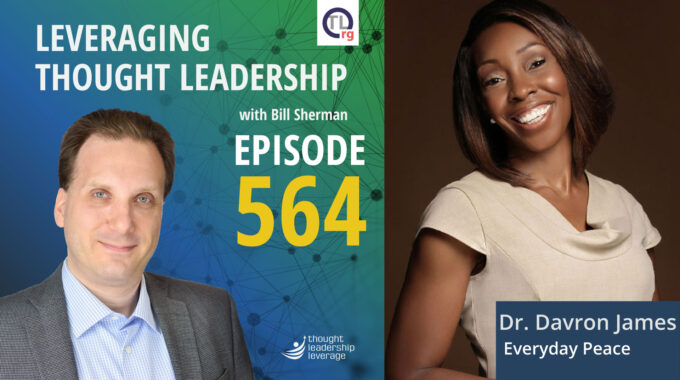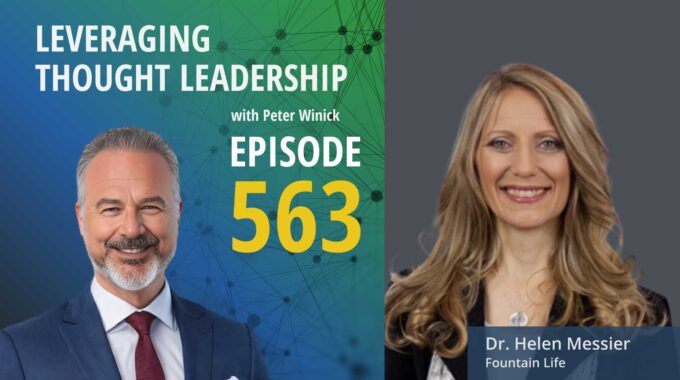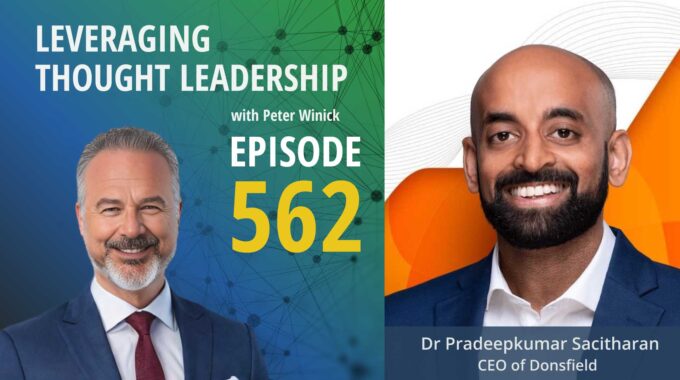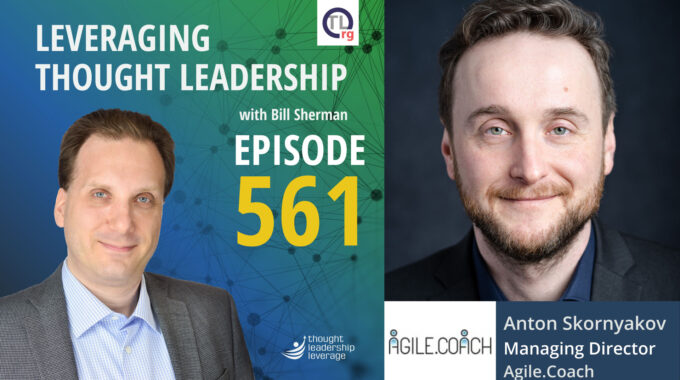Embracing Self-Awareness for Personal Growth and Peace A conversation with Dr. Davron James about her…
Implementing niche solutions at scale | Urvashi Bhatnagar
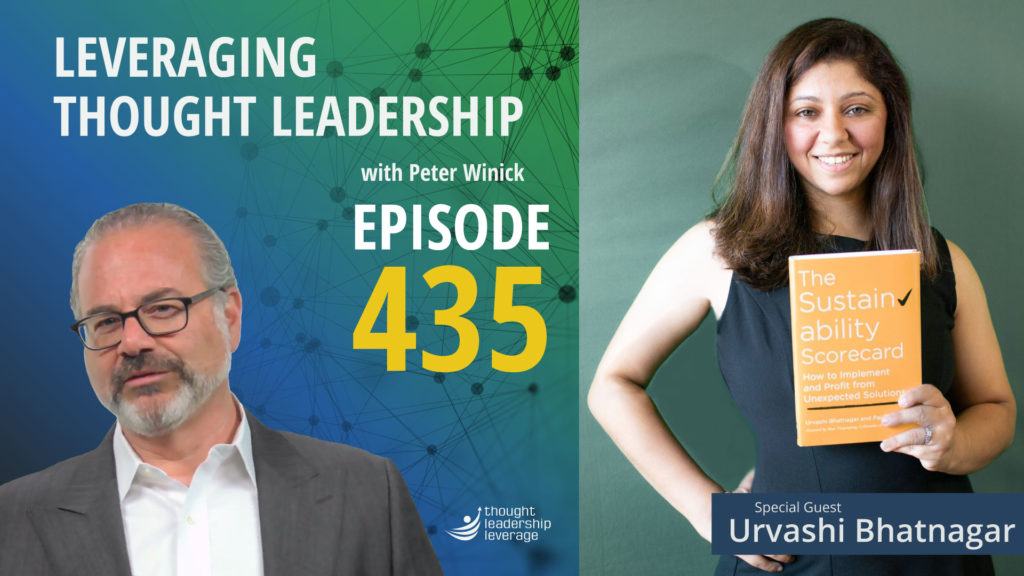
Putting scientific solutions into a book for the general audience.
An interview with Urvashi Bhatnagar about making sustainability solutions accessible to wider audiences.
The principles of Green Chemistry have been widely accepted, but are not widely adopted.
With solutions for sustainable and profitable innovation available, where is the disconnect between these principles and their use?
Our guest on this episode is Urvashi Bhatnagar, Vice President of Business Development for Healthcare at Genpact, a global professional service firm that transforms industries. She is also the co-author of The Sustainability Scorecard: How to Implement and Profit from Unexpected Solutions.
The Sustainability Scorecard was co-written with Paul Anastas (also known as “The Father of Green Chemistry”) while Urvashi was working toward her MBA at Yale. During discussions with Paul about the 12 Principles of Green Chemistry, they examined why those principles had not been widely applied – even though they were widely accepted! With a better understanding of the issues, they proceeded to write a book that would make a big impact in both chemistry and management.
Urvashi shares the three parts of their business model. She discusses advocacy through speaking and engagements, building associated foundations to inspire and support others, and helping people transport important knowledge and structures from one field to another – where big ideas can make a real difference.
We round out the conversation discussing how thought leadership’s ability to help design the future. We hear about the increasing need for thought leadership in private equity and startups, and how moving a chunk of marketing budget to create and support an organization’s thought leadership can strengthen an organization’s reputation and offer an even higher return.
This is a great episode, and we encourage you to listen in!
Three Key Takeaways:
- When taking scientific or research data to a general audience, write with a less academic voice and gear your insights towards leaders.
- When your target market is niche, you have to be very intentional about the content you release.
- Thought Leaders who are conscious leaders – focused on mentoring and enabling – can make great strides in designing a brighter future in multiple fields.
If you need a strategy to bring your thought leadership to market, Thought Leadership Leverage can assist you! Contact us for more information. In addition, we can help you implement marketing, research, and sales. Let us help you so you can devote yourself to what you do best.
Transcript
Peter Winick And welcome, welcome, welcome. This is Peter Winick. I’m the founder and CEO at Thought Leadership Leverage. And you’re joining us on the podcast today, which is Leveraging Thought Leadership. Today, my guest is Urvashi Bontrager. Urvashi is kind of fascinating, so I had a great conversation with her last week. She’s the author of the recent book The Sustainability Scorecard How to Implement and Profit from Unexpected Solutions. She’s an executive in the health care space. So, it’s an interesting blend of a an executive that’s investing time and energy and effort into thought leadership. So, I thought that would be a good basis of our conversation.
Peter Winick Welcome aboard today. How are you?
Urvashi Bhatnagar Thank you. Thrilled to be here.
Peter Winick So let me ask you this. So, you’re busy executive in the health care space, etc., and then you decide or got roped into or suckered into writing a book like how did that happen?
Urvashi Bhatnagar I know I spent years just sitting in a way in a little room typing away. Yeah, well, actually, it was. It was just by chance. During my MBA, I had a sustainability class with my coauthor, Paul Anastas, who is also known as the father of Green Chemistry. And he in his in his first lecture, he spent time talking about the 12 principles of green chemistry and how these principles have driven product and process innovation over the years and are very, very well regarded, peer reviewed and very well adopted. And I thought, wow, they’re so well adopted. And I haven’t heard a thing. And so I spoke with Paul after the class. And, you know, we discuss a variety of subjects why this hasn’t perhaps made its way to the mainstream knowledge base yet. Why is it. Yeah, why is it considered niche subject? And also, why hasn’t a health care lens been taken into the product and process, innovation and development process. And so. This book is an outcome of that initial discussion. My first year of my MBA and I’m so. Well, it’s. Yeah. It’s been a while since then, but.
Peter Winick Right. Right.
Urvashi Bhatnagar But, but I’m glad that it’s finally come to come to the world.
Peter Winick So a couple of things. One is the book is not a technical academic chemistry book by any stretch. Right. It is a general, general business book.
Urvashi Bhatnagar Not at all.
Peter Winick Which was kind of the point. But tell me a little bit about. The process of writing what it took, what your what you might have thought it would have looked like going into it and what you know now on the other side of it.
Urvashi Bhatnagar Yeah. You know, initially when we thought of the book, we were actually thinking of actually a little bit more of an academic book. But as we went through this process, we realized that there was a bigger impact to be had if this scientific information was finally distilled into management principles. And if it was written in a way that was more consumable by anyone, by leaders, by product developers, by startup.
Peter Winick Stay there a second, because I think, yeah, subject matter experts have a choice to make when they’re writing or when they’re putting out any sort of thought leadership. And it’s great to sort of speak in their comfort zone, which tends to be more academic, has to be more technical, whatever, or actually go through the effort and the energy, etc., to make it more applicable, more approachable, more digestible. And that’s a lot harder than it sounds, right?
Urvashi Bhatnagar So it really.
Peter Winick Is. And I hate the term dumbing it down, but the democratization, if you will, of that, you know, is really, really hard, particularly for someone with an academic bent. So I love that this book was a collaboration. Exactly. What are the things that you learn along the way or how many years did it take off your life? Sleepless nights and all tell.
Urvashi Bhatnagar Yeah, I. I definitely revisited my old habits, but. But that said, I developed an appreciation for why this breakthrough material in various fields, not just chemistry, but the solutions are present all across science, especially all across the hard sciences. And I mean, even if you think about the Google graveyard. And so you have pathbreaking innovative products that are just ready for commercialization. But but that doesn’t guarantee success. That doesn’t mean that once this product is out into the world, it’s going to be instantly adopted. People are going to recognize the value and, you know, integrate it into their lives and their processes. So we recognized that our job did not end with distilling this scientific material. We had to go forward. We had to provide strategies for change management for the patient. What would an analyst on the ground be thinking if they had to completely revamp their supply chains, if they had to negotiate with suppliers, if they had to collaborate with traditional competitors? So those are all of the things that we get into in the book because we realized that our responsibility did not stop at simply informing the world that these solutions exist.
Peter Winick So it’s early in the process because books have a long shelf life, no pun intended to me. I always look at a solid business book as at least a 5-to-7-year shelf life, right? If not right. Right. And so it’s too early to see if we’ve hit all the mark. But what were the objectives? What were the some of some of the goals that you had relative to the book?
Urvashi Bhatnagar So one of the I would say actually had many goals, but I would say they all goals lead back to transcending political opinions and preconceived notions. We want this book to be understood for being a business and economics book. It is focused on innovation and operations. And so we don’t want leaders or readers of any color and stripe to be encumbered by their views on climate change or their views on embedded capital and what it’s going to take to create a transformation. We hope we’ve written this in such a way that it clearly demonstrates mankind’s biggest opportunity. We predict that the next wave of high net worth, ultra high net worth individuals are going to be either one. People that develop solutions for climate change mitigation or adaptation and decarbonization or two, they’re going to be investing in them. And so, regardless of your opinion, this is a climate change shock. And we need to be able to respond as a business because we are going to be the first losers.
Peter Winick So stay there for a second because. You know, a topic like climate change has been politicized and we can talk about how ridiculous that is, etc., but it has been that’s whatever. So, it’s not easy to take a topic that’s become a bit of a hot potato. So, you know, I guess at some level, one of the goals and I’m assuming by not saying that it is a goal is not to convince, you know, the unconvinced on the other side that it’s just a coincidence that the temperatures are getting like all these. Like, no, there’s no signs, nothing, you know, keep walk and nothing to look at here. Right. But I like the idea of sort of ignoring that and saying, okay, this is a business operating. This is like the Internet, 1996. So therefore, whether you know, whatever you’re doing on Election Day or whatever, just from a capitalist standpoint, there is opportunity here. Right. There’s a problem that needs to be solved. There’s money that’s going to be thrown at it. They’re smart brains. They’re going to figure out new and innovative and creative ways to to deal with these problems. So I think that’s an interesting piece. What are their goals were there for the book and let me back that up a little bit. Sometimes people will realize after writing a book that one of the benefits it might not have been a goal was intrinsic. Wow. It really forced me to get my thinking together. It really forced me to to pressure test my models. It really forced me to figure out the best way to tell a story or something. Does that does that resonate?
Urvashi Bhatnagar Absolutely. 100%. It forced me and Paul to think really critically about the material that we were putting forth, because if we almost put ourselves in the mind of a VC or someone who was going to put money down on the next innovative product and think what really is the timeline for this? Who is the intended audience? So, so, you know, whether we decide on an example or in this case or pointed out a firm that is doing something right or provided examples of promising solutions for the future, we have really gone back to critically evaluate how when an investor look at this, if they were to solely monitor our Y and, you know, market penetration, those kind of so stay.
Peter Winick There for a minute. So, what I like about that is you’ve got you’re really laser focused as to who the beneficiary and the end user is, right? So, a lot of people come in and say, well, this is a really big topic. Everybody could benefit from this. Everybody should read this. And whether that’s true or not isn’t the point. You can’t market a book or position a book to be all things to all people. For the most part, there are some exceptions to that rule, but saying, Hey, let me look at this problem. It’s a chemistry problem. We’re looking at it economically and we want to look at it through the lens of the financial investor that’s really, really focus. Now, the flip side of that is the total call it whatever. Total addressable market for the book is far less than a good to great or classic business book. And that’s okay. People get sucked into sort of the book industrial complex, you know, numbers and hitting on the list and whatever. And I think the reality is in your world, if the right 100 to 100, 500 and know what the number is, people really internalize and embrace their thinking. That could be a game changer. That is that.
Urvashi Bhatnagar Absolutely. Absolutely. I mean, everything about this piece of thought leadership has been really intentional. And so we’re really grateful. I mean, you think about our forward. We’re so grateful. Mark Tripp Henning, the co-founder of graciously provided us a foreword. Some of our endorsers, for example, the CEO of Volvo Group. And, you know, so Christine Bader, I mean, I could go on. We have intentionally approached people that we’re also evaluating this book through that lens. Which audiences are going to create the biggest impact. First, of course, we want this book to get in the hands of everybody students, lecturers and everybody. But in terms of early adopters, people that are ready to consume this book and immediately create a transformation are people that are asking for this material. That was definitely a primary thought that went into it.
Peter Winick If you’re enjoying this episode of Leveraging Thought Leadership, please make sure to subscribe. If you’d like to help spread the word about our podcast, please leave us a review and share it with your friends. We’re available on Apple Podcasts and on all major listening apps as well as at ThoughtLeadershipLeverage.com/podcasts.
Peter Winick So let me let me pivot a little bit to sort of business models and outcomes. So we talk about the work, we talked about resonance, etc.. What are the underlying business models for you and your coauthors? Is it speaking? Is it consulting? Is it – what does that look like for you?
Urvashi Bhatnagar Yeah. Thank you so much for asking. So, yes, all of the above are really important. They help get the message out there. I would say there are two things that are really important to us. One is we are in progress now with starting a green chemistry trade association to help support the commercialization of really promising products and help support help develop the regulation around it, such that it prevents greenwashing and prevents all of these sort of negative externalities. And as regulation is developed, it really it really prevents sort of, you know, some of the things we see in the market today as it relates to socially.
Peter Winick Just I want to I want to just pause there because a lot of people don’t realize that an association is a business model. It’s a great business model, right? So, A, you get to create the standards to be early. You’ve literally written the book and associations make money. Obviously our membership obviously on events, obviously on sponsorship, etc., etc. and it is one of the businesses or business models where you don’t have to be the first to market, but earlier is better than later.
Urvashi Bhatnagar Absolutely.
Peter Winick Having the you know, you answer the ultimate question of why you all well, we literally wrote the book, right. So, association is really, really cool. Any other business models that you hope to sort of have as an outcome of the book or connected to the book in some way?
Urvashi Bhatnagar Yes. So, we also are thinking of starting a fund that would invest in the very solutions that we talk about in the book to demonstrate that they are credible. They are the solutions we need for the future, and there is a ready audience for them. So, we hope that by way of one is the advocacy, the speaking and the engagement. The second I would call the association to support the regulatory changes and things like that. And then the third is a fund that actually auctions. What we talk about in the book, we hope by way of these three business models that we would actually create the change that we’re talking about.
Peter Winick So we’re seeing more and more in the private equity space, in the fund space, in the startup and investment space, a role in a need for thought leadership. And it’s really, really interesting because take it away from the fund level, but funds investment companies, right? That’s sort of the next step. So, when they’re investing, you know, the next question, the potential investor as well, what’s the use of proceeds? Right. So there’s typically a couple of check the box. We’re going to hire more people. We’ve got to do some R&D. But then there’s a big sales and marketing bucket that usually, not usually, but in many cases can be a sinkhole. Right. And I think what a lot of funds and private equity folks in these and such are realizing that. Reallocating some of that marketing budget to thought leadership yields a higher return and an advantage. So, if an investor came to you. There’s a little bit of a self-selection. If someone read the book and said, Oh, geez, there’s a fund I’m in right now. Again, we don’t want to convert on convertibles. That’s not worth our energy. Your time. But to a subset of people that read that they get, what you’re thinking is they get what your frameworks are. They get what your models are. At some level, you kind of don’t have to sell them. The book does a nice job of telling the story in a really rich and deep way.
Urvashi Bhatnagar Exactly. This is I mean, that’s exactly right. I couldn’t have said it better myself. It is an investment thesis in and of itself. It is. It is providing. So, for example, if even if a legislator wanted to understand a little bit more about this subject and how it applies for people, this is a 500-page answer to that. They can get the 45/2 version from the forward or they can get the one-day version if they read the entire book. So, I completely agree. As it relates to PE firms investing, marketing, budget in thought leadership, I think it’s wise. I think where PE is going is that they’re finally recognizing that they are designing the future leaders designed the future they have an impact on today. But primarily their role is to design the future. And so, if you have a thought leader who is realistic, who is showing you what tomorrow could look like, and that ideal state and what you could move towards while keeping an eye. Yeah.
Peter Winick Yeah. Well, I think there’s I think you’re 100% right. And I think traditionally up until the last. Less than ten years thought leadership has been in many instances, not all. A lot of acceptance. This historical. Here’s what I did to be a great leader. Here’s what I did to be a great manager, etc. And there are some, you know, design thinking, innovation that that do not fit into that framework. Now, what we’re seeing is, is using the thought leadership to say, this is who I am, this is who we are, this is what we believe. These are the macro trends that we see, and this is where it’s going. Come on the bus or not, because of this journey or not. And we’ve laid out a hypothesis. And now along the way, maybe you hit a bump, maybe change something, the model, maybe something gets added, tweak it. That’s okay. It doesn’t have to be a black and white sort of thing. But I love the idea of someone having the courage and the guts to go. It’s one thing to do a 20-deck slide, who cares? But a 500-page book that’s taking you 3 to 4 years of 2 to 3 people’s lives. That’s a big deal, you know?
Urvashi Bhatnagar Right.
Peter Winick Interesting. Any final thoughts, reflections or insights to share with others based on your journey so far?
Urvashi Bhatnagar Yeah, I have realized that thought leadership is critical. It helps you design the future. But I think thought leaders that are conscientious leaders, that is they are focused on mentoring. They’re focused on enabling the next Google or the next innovator while having that critical operator experience is really what I would call the silver bullet. Yeah. You know, the.
Peter Winick Magic, right?
Urvashi Bhatnagar Yeah, the magic in a bottle. And so, someone who has their own theories and is able to provide you a vision for the future, I think is a great thought leader. I would encourage more, more leaders to think of themselves as designers for the future after they have definitely proven they’re proving their mettle.
Peter Winick I love it. Well, thank you for spending time with us today, Urvashi, this has been fantastic. Thank you.
Urvashi Bhatnagar Thank you so much, I’ve loved being here.
Peter Winick To learn more about Thought Leadership Leverage, please visit our website at Thought Leadership Leverage dot com to reach me directly. Feel free to email me at Peter at ThoughtLeadershipLeverage.com and please subscribe to Leveraging Thought Leadership on iTunes or your favorite podcast app to get your weekly episode automatically.



